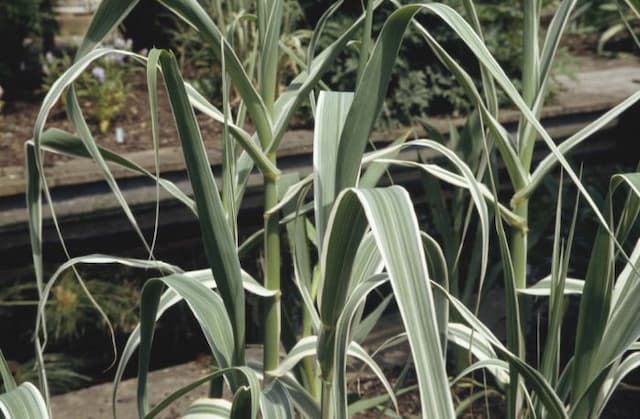Giant reed Arundo donax











ABOUT
The plant known as giant reed possesses a strong, reed-like appearance, characterized by tall stalks that resemble those of bamboo, although it is not related to bamboo. Its stems are typically hollow between the joints, much like the familiar structure of a bamboo plant. The foliage is lush, with leaves that are elongated and tapered, resembling blades of grass. They are green and may have a rough texture to the touch. The leaf margins are smooth, contributing to a sleek overall leaf shape. In its blooming season, giant reed produces feathery plumes atop its stems. These plumes are often creamy white to silver in color and appear fluffy, giving the plant a soft, ornamental aspect. The combination of its stiff stems and soft, waving plumes creates an interesting visual contrast within natural landscapes or when used as an ornamental plant.
About this plant
 Names
NamesFamily
Poaceae.
Synonyms
Giant Reed, Spanish Cane, Wild Cane, Giant Cane, Arundo, Colorado River Reed, Elephant Grass, Carrizo, Caña de Castilla, Varilla, German Reed, Ripgut, Bamboo Reed.
Common names
Arundo bengalensis, Arundo collina, Arundo glauca, Arundo sativa, Arundo versicolor, Donax arundinaceus.
 Toxicity
ToxicityTo humans
Giant Reed (Arundo donax) is not commonly known for being toxic to humans. There's limited information on its poisonous attributes when it comes to human ingestion. However, as with many plants, it is advised not to consume any part of Giant Reed without proper knowledge and preparation, as it may have adverse effects or contain harmful compounds not typically characterized for human consumption.
To pets
Similar to its effects on humans, Giant Reed (Arundo donax) is not widely recognized for being poisonous to pets. There is a lack of substantial evidence indicating pronounced toxicity in animals from ingestion of this plant. Nonetheless, pet owners should prevent pets from ingesting Giant Reed as a precautionary measure due to the possibility of unforeseen sensitivities or the presence of irritants that could cause mild gastrointestinal discomfort.
 Characteristics
CharacteristicsLife cycle
Perennials
Foliage type
Deciduous
Color of leaves
Green
Flower color
Varies
Height
20 feet (6 meters)
Spread
6 feet (1.8 meters)
Plant type
Grass
Hardiness zones
7
Native area
Mediterranean
Benefits
 General Benefits
General Benefits- Erosion control: Arundo donax, commonly known as giant reed, grows rapidly and establishes strong root systems that can help stabilize soil and prevent erosion.
- Bioenergy production: It has high biomass yield potential, making it a candidate for renewable energy sources like biofuel and biopower.
- Phytoremediation: The plant can absorb and accumulate heavy metals from contaminated soils, aiding in the removal of pollutants.
- Building materials: The canes of the giant reed are strong and can be utilized in construction as a natural building material.
- Ornamental use: With its tall stature and feathery plumes, it is used as a decorative plant in gardens and landscapes.
- Habitat creation: It can provide habitat and nesting materials for certain wildlife species, although in some regions it can also be invasive and disrupt local ecosystems.
- Music instrument production: The canes are traditionally used for making reeds for woodwind instruments such as clarinets, saxophones, and oboes.
- Agricultural uses: As a fast-growing plant, it can be employed as a windbreak or privacy screen in agricultural settings.
- Wastewater treatment: It can be used in constructed wetlands for the treatment and management of wastewater.
- Crafts and art: The versatile canes can be used for making crafts, furniture, and even paper.
 Medical Properties
Medical Properties- Anti-inflammatory: Some studies suggest that Arundo donax has properties that may reduce inflammation.
- Antimicrobial: It has been researched for potential antimicrobial activity against certain pathogens.
- Antioxidant: The plant may contain compounds with antioxidant effects, which help in preventing oxidative stress.
- Analgesic: There is some evidence that Arundo donax might have pain-relieving properties.
- Diuretic: Traditionally, it might have been used to promote the excretion of urine.
 Air-purifying Qualities
Air-purifying QualitiesThis plant is not specifically known for air purifying qualities.
 Other Uses
Other Uses- As a windbreak and to prevent soil erosion: Arundo donax, or giant reed, is planted in rows to act as a barrier against strong winds and to hold soil in place with its robust root system.
- For musical instruments: The canes of the giant reed are used for making reeds for woodwind instruments such as saxophones, clarinets, and oboes.
- In construction of bio-filters: The fibrous root system of the giant reed can be utilized in the construction of bio-filters for wastewater treatment.
- As bioenergy crop: Arundo donax can be grown as an energy crop because it has a high biomass yield and can be converted into biofuel.
- In paper manufacturing: The fibers from the giant reed can be processed and used in the production of paper and pulp.
- For handicrafts and basketry: The flexible stems of the giant reed are suitable for making a variety of woven goods like baskets and mats.
- As a fencing material: The tall, dense growth of giant reed can be cultivated and trimmed to form living fences or privacy screens.
- For ornamental purposes: Due to its rapid growth and lush foliage, Arundo donax can be used as an ornamental plant in large gardens and parks.
- In phytoremediation: The giant reed is capable of absorbing heavy metals from contaminated soils, making it useful in phytoremediation projects.
- As a sound barrier: The thick stands of Arundo donax can help to reduce noise pollution when planted along highways or industrial areas.
Interesting Facts
 Feng Shui
Feng ShuiThe Giant Reed is not used in Feng Shui practice.
 Zodiac Sign Compitability
Zodiac Sign CompitabilityThe Giant Reed is not used in astrology practice.
 Plant Symbolism
Plant Symbolism- Growth: Arundo donax, known commonly as Giant Reed, often symbolizes rapid growth due to its ability to reach considerable heights quickly.
- Invasiveness: Given its reputation as an invasive species, the Giant Reed can symbolize domination or the unchecked spread of ideas or influence.
- Adaptability: The Giant Reed is known to adapt to a variety of environments, representing flexibility and resilience.
- Music: Traditionally, the Giant Reed has been used to make reeds for woodwind instruments, making it a symbol of music and creativity.
 Water
WaterThe giant reed, Arundo donax, prefers consistently moist soil, so water it deeply until the soil feels saturated to a depth of several inches. In general, this plant should be watered once a week, but you may need to adjust the frequency to maintain moisture during particularly hot or dry periods. Aim for about 1 to 1.5 gallons of water per week under normal conditions, increasing the amount if the weather is unusually hot or dry and decreasing it during rainy periods. Avoid overwatering as standing water can lead to root rot.
 Light
LightThe giant reed thrives in full sun to partial shade. For the healthiest growth, plant it in a location where it can receive at least six hours of direct sunlight each day. However, it can also tolerate some shade, especially in hotter climates.
 Temperature
TemperatureThe giant reed can tolerate a wide range of temperatures but performs best when the daytime temperature is between 68°F and 86°F. It can survive minimum temperatures down to around 20°F, though it will go dormant in colder conditions. This plant is quite hardy and can adapt to different climates but should be protected from frost to prevent damage to the foliage.
 Pruning
PruningThe giant reed should be pruned to control its growth and encourage new shoots. Prune in late winter or early spring before new growth begins. Remove any dead or damaged canes at their base to maintain the plant's appearance and health. It's not necessary to prune every year, but doing so every few years can help rejuvenate older clumps.
 Cleaning
CleaningAs needed
 Soil
SoilThe Giant Reed (Arundo donax) thrives best in a rich, loamy soil that ensures good drainage while retaining some moisture. A mixture of two parts garden soil, one part sand, and one part peat or compost is ideal. The soil pH should be between 6.0 and 7.5 to promote optimal growth.
 Repotting
RepottingGiant Reed should be repotted when it outgrows its container, which can be every 2 to 3 years due to its fast growth rate. For mature plants, instead of repotting, divide and replant the rhizomes to manage size and spread.
 Humidity & Misting
Humidity & MistingThe Giant Reed prefers moderate to high humidity levels but is quite adaptable and can tolerate lower humidity environments as long as it has sufficient water.
 Suitable locations
Suitable locationsIndoor
Ensure bright light, ample space, and large pot for Giant Reed.
Outdoor
Plant in full sun, moist soil, and space clumps for Giant Reed.
Hardiness zone
6-10 USDA
 Life cycle
Life cycleGiant Reed (Arundo donax) begins its life cycle from seeds or rhizome fragments, with seed germination occurring if conditions are optimal—moist soil and sunny conditions. After germination, seedlings establish a root system and grow rapidly, thanks to its rhizomatous nature that allows vegetative propagation and spreading. As it matures, Giant Reed forms dense stands of tall, bamboo-like stalks, which can reach up to several meters in height. Throughout its life, the plant undergoes vegetative growth, developing long leaves and thick culms. Flowering typically occurs in late summer or autumn when feathery, plume-like panicles appear, though it seldom sets viable seeds in many non-native regions. Consequently, its primary mode of reproduction and dispersal is through its extensive and persistent rhizome network, which can lead to the formation of new shoots even after the above-ground structures are damaged or cut back.
 Propogation
PropogationPropogation time
Spring-Early Summer
Propogation: The giant reed, Arundo donax, is commonly propagated by dividing its rhizomes, which are underground stems capable of producing the new plant. The ideal time for this method is late winter to early spring before new growth begins. Rhizomes are excavated and cut into sections, ensuring that each section has at least one bud. These sections are then planted horizontally in moist soil, around 1 to 2 inches deep (approximately 2.5 to 5 cm). This rhizome division method allows the giant reed to quickly establish in a new location, leveraging its robust nature and strong growth rate once the temperatures are warm enough to encourage growth. The rapid establishment from rhizome segments makes this the most popular propagation method for Arundo donax.









